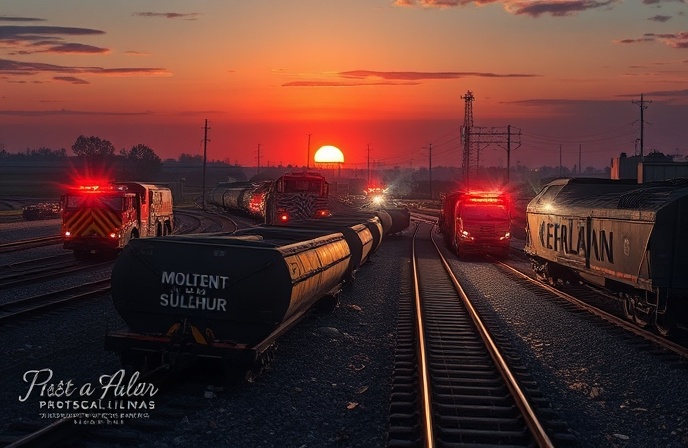NTSB: Norfolk Southern Derailment, Illinois, Rail Safety Investigation
NTSB investigates Illinois train derailment, raising safety concerns for Norfolk Southern Railway.

NTSB Investigates Norfolk Southern Derailment in Illinois, Raising Safety Concerns
A Norfolk Southern Railway (NS) freight train derailed near Browns, Illinois on July 18th, prompting an investigation by the National Transportation Safety Board (NTSB). The incident, which occurred at approximately 7:00 PM, involved the derailment of 24 rail cars, some of which were carrying molten sulfur. Two crew members sustained non-life-threatening injuries. This derailment resulted in the temporary closure of several roadways, including Illinois Route 15. The NTSB investigation aims to determine the cause, which is currently unknown. This article will delve into the details of the incident, examine the potential implications for the rail industry, and explore the ongoing investigation.
Incident Overview: The Browns, Illinois Derailment
The derailment took place on the evening of July 18th near the small community of Browns in southeastern Illinois. According to local news reports citing NS, the derailed cars contained various commodities, with a portion transporting molten sulfur, a hazardous material commonly used in the production of fertilizers and other industrial applications. The release of molten sulfur necessitated immediate response protocols, including securing the scene and mitigating any potential environmental impact. The incident required a coordinated response from local first responders. The Mayor of Mount Carmel, Joe Judge, announced on Facebook that the area was secured by 5:00 AM on July 19th, and first responders were released from the scene on July 20th. The NTSB investigation will focus on several key areas, including track conditions, train speed, and potential mechanical failures.
Hazardous Materials Response and Containment Procedures
The presence of molten sulfur underscores the importance of robust emergency response protocols in rail operations. These protocols, mandated by regulations such as the Department of Transportation’s (DOT) Hazardous Materials Regulations (HMR), dictate procedures for containing and mitigating spills. The response to this incident, which included the deployment of hazmat teams and the temporary closure of roadways, will likely be scrutinized as part of the NTSB investigation. The investigation will assess the effectiveness of NS’s response plan, including the training of personnel and the availability of specialized equipment designed to address hazardous material releases. Furthermore, the investigation will consider compliance with federal regulations regarding the transportation of hazardous materials.
Track Conditions and Infrastructure Analysis
A critical aspect of the NTSB’s investigation will be the examination of track conditions at the derailment site. This will involve a detailed inspection of the rail, ties, ballast, and surrounding infrastructure to identify any contributing factors. The investigation may consider the age and maintenance history of the track, as well as any recent inspections or repairs. It’s common for railway operators to employ technologies to improve track maintenance, such as ultrasonic testing, which detects internal rail flaws, and ground penetrating radar, which scans the ballast to check for degradation and ensure proper drainage. The investigation may also assess the impact of weather conditions, such as extreme temperatures or heavy rainfall, on the track infrastructure.
Investigation and Remediation
The NTSB investigation will take months and involve detailed analysis of all contributing factors. Once the cause is determined, the NTSB will issue recommendations designed to prevent similar incidents from occurring in the future. These recommendations may be directed to NS, the Federal Railroad Administration (FRA), and other industry stakeholders. Remediation efforts will be conducted by NS after the investigation to address any track damage, restore service, and ensure the safety of the surrounding environment. The complete process may include the removal of debris, the repair or replacement of damaged track components, and the environmental cleanup of any released materials. The long-term implications of this event will depend heavily on the findings of the NTSB and the resulting changes that occur within the rail industry.
Conclusion
The derailment of the Norfolk Southern train near Browns, Illinois, serves as a stark reminder of the inherent risks involved in rail transportation, particularly when hazardous materials are involved. The ongoing NTSB investigation will be crucial in determining the root causes of the incident and identifying areas for improvement in safety protocols and infrastructure maintenance. The incident’s aftermath, including the clean-up and potential environmental impacts, will highlight the importance of robust hazardous materials response strategies. This investigation will likely examine the performance of NS’s safety management systems, track maintenance practices, and crew training. The results of this investigation will undoubtedly shape industry regulations and best practices, potentially leading to further investment in track infrastructure, improved inspection technologies, and enhanced safety protocols for the transportation of hazardous materials. Future advancements may include the use of artificial intelligence for predictive maintenance and improved derailment detection systems.
Company Summary: Norfolk Southern Railway
Norfolk Southern Railway (NS), headquartered in Norfolk, Virginia, is a major Class I freight railroad operating across a vast network in the Eastern United States. NS transports a wide range of commodities, including coal, intermodal freight, automobiles, and chemicals, making it a vital component of the nation’s supply chain. NS is a major player in the railway industry, and invests heavily in its infrastructure to improve its safety and efficiency. The company’s operations are subject to federal regulations and stringent safety standards, including regular inspections, employee training programs, and adherence to the latest safety technologies. NS is an important part of the North American railway network, with a large role in domestic and international trade.


